|
NOUNS
Traditional grammarians define a noun as "a
person, place, thing, or idea."
Child designates a person;
therefore, child is a noun.
Similarly, democracy designates an
idea; therefore, democracy is a noun.
In addition, nouns can be identified by the
presence of signal words such as the.

Word order can also provide clues about nouns.
For example, in the following sentence, it is clear that the part of
speech that will fit into slot #1 and slot #2 must be nouns:

Often, suffixes will suggest that a word is a
noun. For example, -tion,
-ness, -ment, or -er at the end of a word usually signify that the word is a
noun, as in suggestion, happiness, involvement, and diner.
Nouns may be made plural, usually with the suffix
-s or -es, as in books and foxes.
Nouns show ownership with the addition of an
apostrophe and, sometimes, an additional -s, as in a book's pages,
twenty students' essays.
Common nouns such as school, business, or
person designate an entire class.
Proper nouns, on the other hand, designate
a specific example of a class: Towson
University, Black and Decker Company, Joe.
Proper nouns are capitalized.
Nouns may be countable (1 fork, 2 forks, 3
forks, etc.) or non-countable (sugar, oil).
Nouns may signify concreteness (computer,
fingernail) or abstractness (peace, friendship).
Functions
of Nouns
Subject
(S) - a noun or pronoun partnered with a predicate verb.
A
subject
1. does an action with an action verb

2. exists with a verb of being
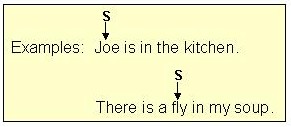
3. is renamed or described after a verb of being or a linking verb
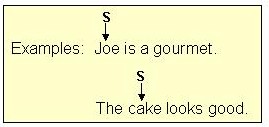
4. is acted upon with a passive verb

Object of Preposition (OP) - a noun or
pronoun answering "whom" or "what" after a
preposition in a
a prepositional phrase.

Direct
Object (DO) - a noun or pronoun answering "whom" or
"what" after an action verb. A direct object
"receives" or is the "object" of the action.

Retained
Object (RO) - a noun or pronoun answering "whom" or
"what" after a passive verb.

Indirect
Object (IO) - a noun or pronoun answering "to whom/what" or
"for whom/what" after an action verb.
An
indirect object

Subjective
Complement (SC) - a noun, pronoun, or adjective
that renames or describes (equals) the subject after a
verb of being or a
linking verb.
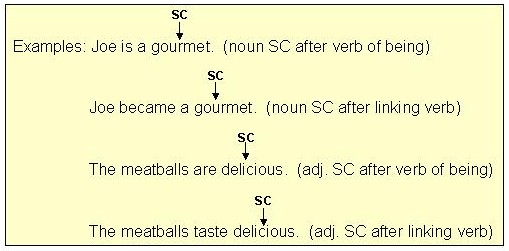
Objective
Complement (OC) - a noun, pronoun, or adjective that renames or describes
(equals) the direct object.
Test
for OC: insert "to be" between the DO and the OC
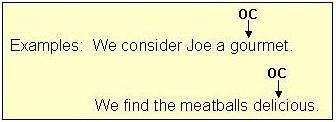
Appositive
(App) - a noun or pronoun that renames another noun; An appositive is
usually placed next to the noun it renames..

Gourmet renames the noun Joe.
Therefore, gourmet is an appositive of Joe.
When an appositive is not placed next to the noun it renames, the appositive is
called a delayed appositive.

A delayed appositive may rename the word it in some sentence constructions.
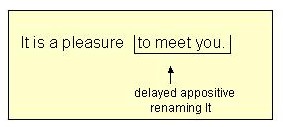
In the above sentence, the appositive to meet you
renames it.
It (to meet you) is a pleasure.
In this sentence, pleasure is the
subjective complement of
it.
Therefore, it = pleasure = to meet you.
|